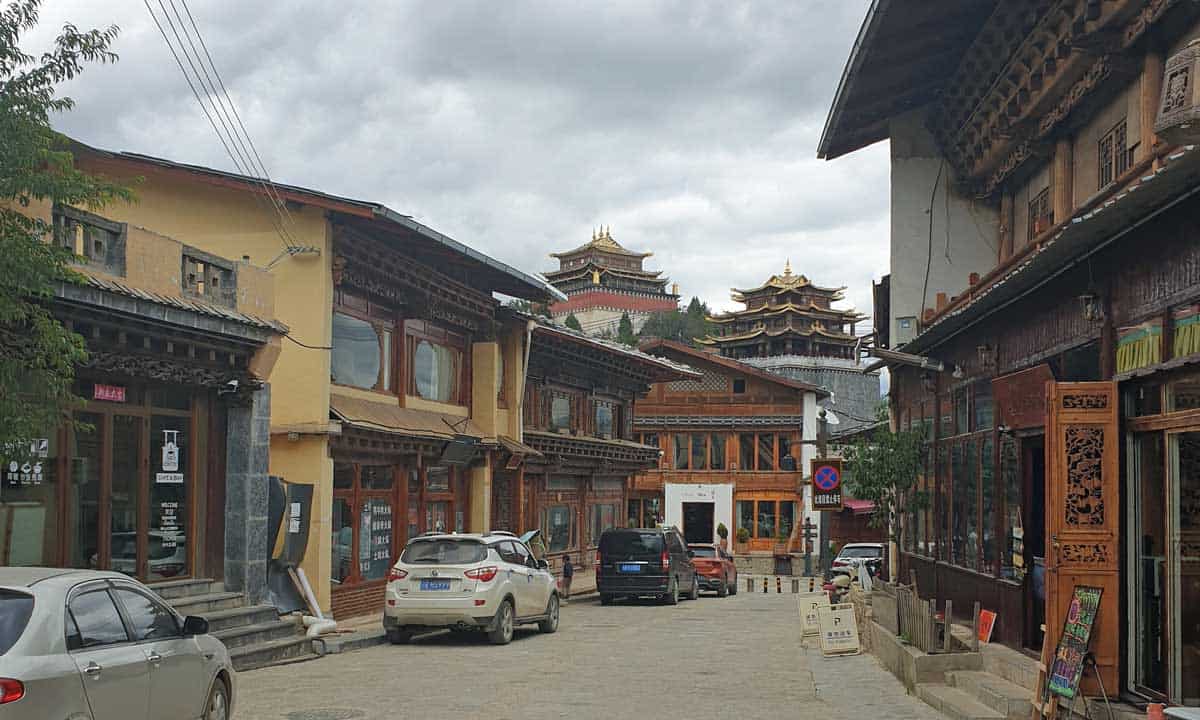Lijiang is known as something of a tourist trap (although, there’s something to be said for it), but if you are a cynic, Shangri-la takes the cake when it comes to overt pandering to tourists.
The name (change) is a dead give-away… but it should not keep you away.
Actually, Shangri-la, the town formerly known as Zhongdian, is quite an interesting place to visit.
The Appeal of This Shangri-La
There is some tourist development that is questionable, but there is also a lot that speaks for it – including in the infrastructure development that may well make things easier for the visitor.
Topmost on my mind: From the Bai minority stronghold of Dali, past the Naxi town of Lijiang, Xianggelila/Shangri-la leads into a distinctly Tibetan part of China. One of the most easily accessible Tibetan parts of China, thanks to all the tourism promotion.

There are interesting Tibetan areas in Sichuan that are relatively close by Chengdu and where mountains start rising up tremendously.
One can get into an area that is a part of the Tibetan plateau by visiting Qinghai.
All well and good – but not the easiest to reach, either.
Tibet proper can only be visited with quite a few hassles and hurdles to take along the way.
Shangri-la, in contrast, is a natural extension of the now-tourist Tea Horse Road (and was a part of the actual ancient trade path), increasingly accessible because of that – and thus, rather easier to get to.

Shangri-la’s “Old” Town (Dukezong)
The old town, like so many of them, is largely a recreation.
Here, too, a fire destroyed a lot of the actual old architecture. The new buildings are recognizably new and somewhat uniform, but still in local style, recognizably different from the architecture in other parts – of the town, and of most of China.
In the center of Shangri-la’s old town lies the Guishan (“Turtle Hill”) Temple.

The illumination at night is, if somewhat fanciful, still a sight; the temple is nice to walk up to and around a bit, too. Only the giant, world’s largest, prayer wheel is a very peculiar attraction, in my opinion – and when I visited, for whatever reason, it was cordoned off, anyways.
All the old town is nice to walk around and explore; there are quite a few museums, and even more shops and restaurants, that are of some interest. It is all not the most exciting, but that may just add to the draw.

Old and New – and Old (and New) Again
Contrasts throughout “Shangri-la” are quite peculiar.
There is the old town that is not really old, but rebuilt. But rebuilt in local traditional style. It is very tourist-oriented, but that still includes some arts and crafts offerings that are very interesting. Some of the restaurants here are also nicely traditional in their offerings, only with menus that make it easy for Chinese and even Western tourists to know what is on offer.

Then there is the new town. It may well be older than the old town’s current construction, but the buildings here are often barely, if at all, referencing traditional building styles.
Much more of everyday life takes place here, however – including the “wet” markets that I am always interested in. This time around, I was particularly interested. I took this trip to find out more about the chilli in this part of China, and particularly to go for the search for a mysterious golden Tibetan tree chilli, a.k.a. Nixi chilli (?) – and I found the first of it at a big farmer’s market in Shangri-la!
Further out in the surroundings, the architecture often features the most interesting modernization of buildings I have yet seen in China: Now that glass and steel have become cheap (and durable?), I assume, one often finds glasshouses. Not attached to the houses or somewhere on the grounds, however. Rather, they are built right over the older houses!
I very much wonder if this makes for a difference in temperatures and comfort, but it sure was an interesting hybrid.

Around Shangri-la
Comfort was a bit of an issue to think about.
We (I was traveling with a colleague) stayed in a guest house that was nice enough, but being here in October, it was also cold enough.
Rain caught us a few times.
I would have loved to go explore the surroundings running, but some health issue made me take a step back and be careful – even (or especially) as I was finally at a high-enough altitude to trigger altitude adaptation / performance checks on a sports/outdoors watch of mine.
There was, however, a side trip further along the road towards Lhasa, to the area around Nixi. This, continuing the search for that golden Tibetan chilli, proved quite fascinating, with impressions to last.
And, I had to pay the “little Potala” of Songzanling monastery near Shangri-la a visit!
At this monastery, Shangri-la truly proves its worth as a place where one can get an impression of Tibet without much of the hassle that an actual trip there would entail.


Leave a Reply